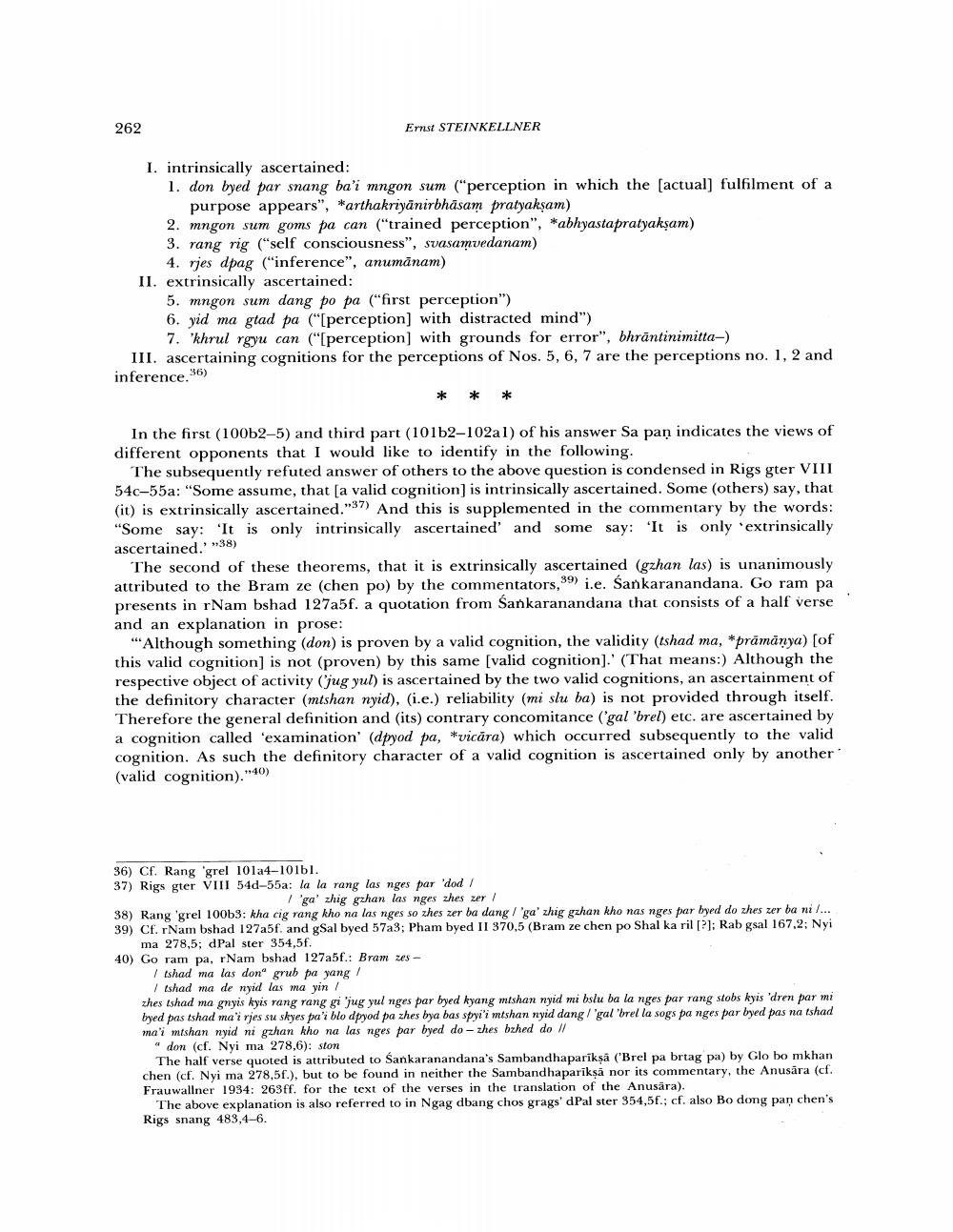Book Title: Early Tibetan Ideas On Ascertainment Of Validity Author(s): Ernst Steinkellner Publisher: Ernst Steinkellner View full book textPage 6
________________ 262 Ernst STEINKELLNER I. intrinsically ascertained: 1. don byed par snang ba'i mngon sum ("perception in which the actual] fulfilment of a purpose appears", *arthakriyānirbhāsam pratyakşam) 2. mngon sum goms pa can ("trained perception", *abhyastapratyakşam) 3. rang rig ("self consciousness", svasamvedanam) 4. rjes dpag ("inference", anumānam) II. extrinsically ascertained: 5. mngon sum dang po pa ("first perception") 6. yid ma gtad pa ("[perception) with distracted mind") 7. 'khrul rgyu can ("[perception) with grounds for error", bhrāntinimitta-) III. ascertaining cognitions for the perceptions of Nos. 5, 6, 7 are the perceptions no. 1, 2 and inference. 56) In the first (100b2-5) and third part (10152-102al) of his answer Sa paņ indicates the views of different opponents that I would like to identify in the following. The subsequently refuted answer of others to the above question is condensed in Rigs gter VIII 54c-55a: "Some assume, that a valid cognition) is intrinsically ascertained. Some (others) say, that (it) is extrinsically ascertained."37) And this is supplemented in the commentary by the words: "Some say: 'It is only intrinsically ascertained' and some say: 'It is only 'extrinsically ascertained. 38) The second of these theorems, that it is extrinsically ascertained (gzhan las) is unanimously attributed to the Bram ze (chen po) by the commentators, 59) i.e. Sankaranandana. Go ram pa presents in rNam bshad 127a5f. a quotation from Sankaranandana that consists of a half verse and an explanation in prose: "**Although something (don) is proven by a valid cognition, the validity (tshad ma, *prämänya) [of this valid cognition) is not (proven) by this same [valid cognition).' (That means:) Although the respective object of activity (jug yul) is ascertained by the two valid cognitions, an ascertainment of the definitory character (mtshan nyid), (i.e.) reliability (mi slu ba) is not provided through itself. Therefore the general definition and its) contrary concomitance ('gal 'brel) etc. are ascertained by a cognition called 'examination (dpyod pa, *vicāra) which occurred subsequently to the valid cognition. As such the definitory character of a valid cognition is ascertained only by another (valid cognition)."40) 36) Cf. Rang 'grel 101a4-101bl. 37) Rigs gter VIII 540-55a: la la rang las nges par 'dod / l 'ga' zhig gzhan las nges zhes zer / 38) Rang 'grel 100b3: kha cig rang kho na las nges so zhes zer ba dang/ 'ga' zhig gzhan kho nas nges par byed do zhes zer ba nil... 39) Cf. rNam bshad 127a5f. and gSal byed 57a3; Pham byed II 370,5 (Bram ze chen po Shal ka ril[?]; Rab gsal 167,2; Nyi ma 278,5; dPal ster 354,5f. 40) Go ram pa, rNam bshad 127a5f.: Bram zes - / Ishad ma las don" grub pa yang /shad ma de nyid las ma yin/ zhes Ishad ma gnyis kyis rang rang gi 'jug yul nges par byed kyang mtshan nyid mi bslu ba la nges par rang stobs kyis 'dren par mi byed pas tshad ma'i rjes su skyes pa'i blodpyod pa zhes bya bas spyi'i mtshan nyid dang/gal 'brella sogs pa nges par byed pas na tshad ma'i mtshan wyid ni gzhan kho na las nges par byed do-zhes bzhed do // "don (cf. Nyi ma 278,6): ston The half verse quoted is attributed to Sankaranandana's Sambandhapariksa ('Brel pa brtag pa) by Glo bo mkhan chen (cf. Nyi ma 278,5f.), but to be found in neither the Sambandhaparikså nor its commentary, the Anusara (cf. Frauwallner 1934: 263ff. for the text of the verses in the translation of the Anusara). The above explanation is also referred to in Ngag dbang chos grags' dPal ster 354,58; cf. also Bo dong pan chen's Rigs snang 483,4-6.Page Navigation
1 ... 4 5 6 7 8 9 10 11 12 13 14 15 16 17
